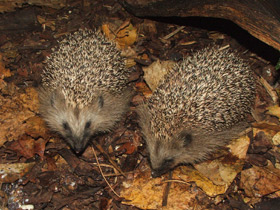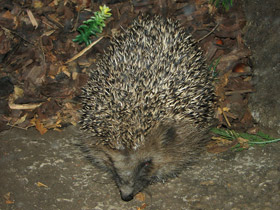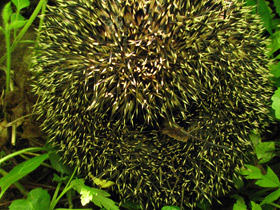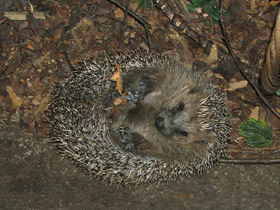The European hedgehog (Erinaceus europaeus), West European hedgehog or common hedgehog
The European hedgehog (Erinaceus europaeus), also known as the West European hedgehog or common hedgehog, is a hedgehog species native to Europe from Iberia and Italy northwards into Scandinavia and westwards into the British Isles.
Description, distribution and diet
Erinaceus europaeus is a species of erinaceomorph mammal in the family Erinaceidae, formerly included in the former order Insectivora.
Erinaceus europaeus is a small nocturnal predator (body length 20-30 cm, weight 700-800 g) with a short tail of 3 cm. It mainly inhabits mixed and broadleaved forests, but also penetrates taiga and steppe. Erinaceus europaeus can be found in neglected gardens, parks and even in cereal fields bordering forests. During the day it hides under piles of undergrowth and leaves among bushes, while at night it comes out to feed. During the night, Erinaceus europaeus sometimes walks up to 3 km. In the dark, it finds food with its acute sense of smell, although it is aided to some extent by its eyesight and hearing. Erinaceus europaeus feeds on beetles, earthworms, woodworms, molluscs, newts, frogs, toads, lizards, snakes, mice, voles and shrews, as well as berries, acorns and ripe fruit fallen from apple, pear and other trees.
Behaviour
In an emergency, Erinaceus europaeus curls into a ball, pressing its head against its belly and tucking its legs and tail under itself: this gives it a spiny ball with needles sticking out in all directions. The hedgehog's needles are modified hairs, located only on the back: the muzzle and abdomen are covered with the usual wool. When encountering forest animals (wolf, marten, fox), Erinaceus europaeus snorts and jumps, trying to poke the enemy. If this does not help, it curls into a ball, exposing its spiny back to the attacking predator. Often, the attacker leaves the hedgehog alone after pricking its snout with needles. But this is not always the case.
There are some enemies of Erinaceus europaeus, from which neither needles nor rolling into a ball will save it. Thus, during night hunting the hedgehog is successfully attacked by the owl. Eagle needles are no problem for it because the eagle's fingers are covered with tough scales. The owl's soft plumage makes its flight silent and allows it to catch its prey unawares. The Erinaceus europaeus cannot escape the fox, which carefully steps on it at the edge of a forest puddle or marsh and throws it into the water. The water penetrates the belly of the Erinaceus europaeus, which straightens its back, stretches out its snout and swims towards the shore. At that moment a fox is waiting for it and with its sharp teeth bites off the head, which is not protected by the needles, and kills the Erinaceus europaeus.
But when it encounters the snake Erinaceus europaeus it emerges victorious. It grabs its tail and immediately rolls itself into a ball. The viper will find needles in its first bite. Meanwhile, Erinaceus europaeus slowly drags the viper under and then eats it. Erinaceus europaeus is not very sensitive to viper venom and also to many poisonous substances. It eats, for example, shpanish flies containing cantharidin, which is deadly to other animals, stinkbugs, bee venom, bumblebees, the corrosive blood of ladybirds and hairy caterpillars.
Reproduction and lifestyle
In spring (April), the hedgehog gives birth to 5-7 blind young with soft, whitish needles. Until they are one month old, the young remain in a nest built by the female in the form of a hut made of dry leaves, twigs and moss. If a human or animal discovers the nest, the hedgehog carries its young between its teeth to another burrow. After 1.5-2 months, the hedgehogs leave the nest, but do not start their independent life until late autumn. In winter (in October), hedgehogs fatten up and hibernate in dense bushes, hollows in the ground covered with fallen leaves and in the undergrowth of the forest. Erinaceus europaeus awakens only with the end of frost.



















































